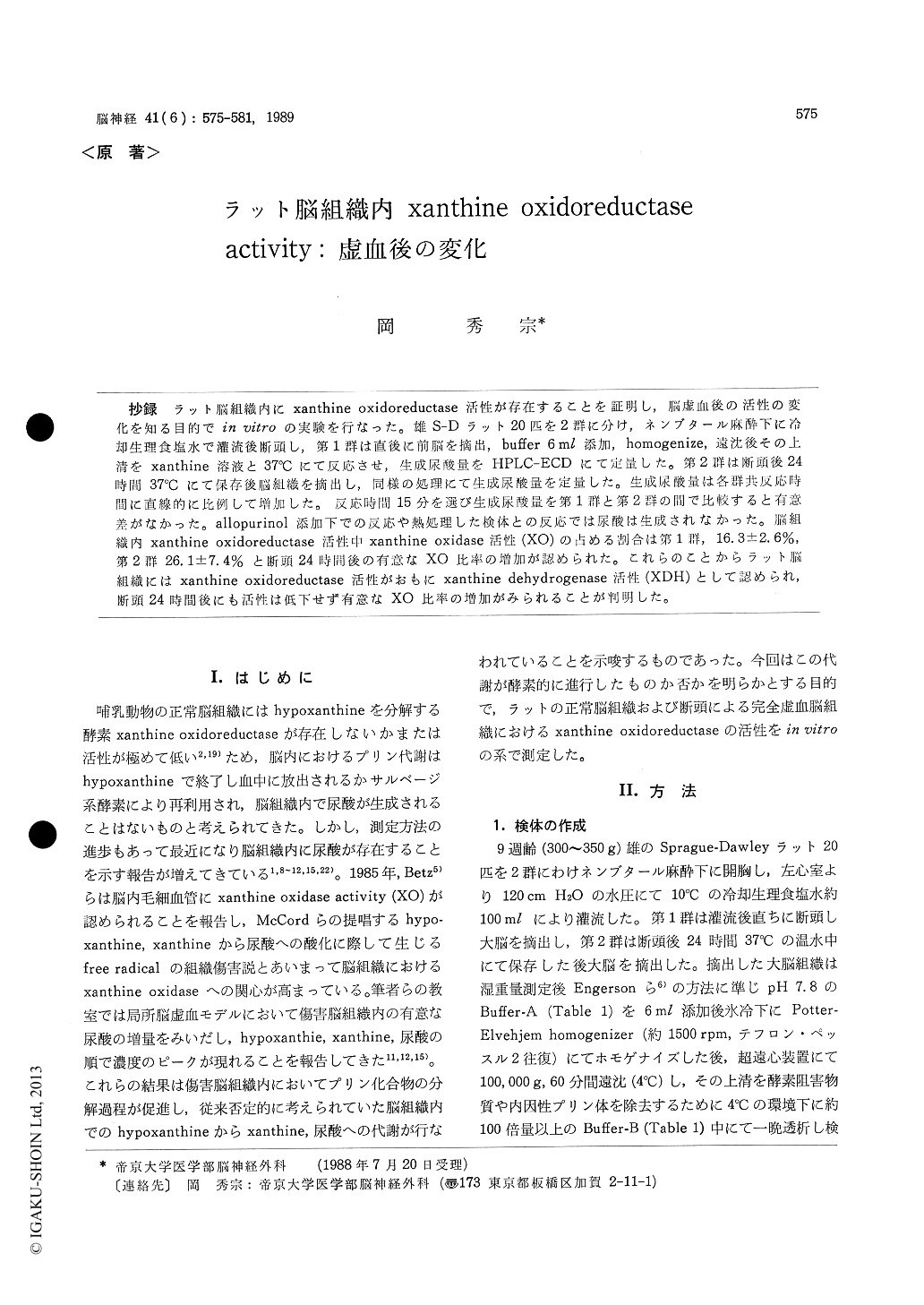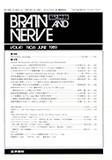Japanese
English
- 有料閲覧
- Abstract 文献概要
- 1ページ目 Look Inside
抄録 ラット脳組織内にxanthine oxidoreductase活性が存在することを証明し,脳虚血後の活性の変化を知る目的でin vitroの実験を行なった。雄S-Dラット20匹を2群に分け,ネンブタール麻酔下に冷却生理食塩水で灌流後断頭し,第1群は直後に前脳を摘出,buffer 6ml添加,homogenize,遠沈後その上清をxanthine溶液と37℃にて反応させ,生成尿酸量をHPLC-ECDにて定量した。第2群は断頭後24時間37℃にて保存後脳組織を摘出し,同様の処理にて生成尿酸量を定量した。生成尿酸量は各群共反応時間に直線的に比例して増加した。反応時間15分を選び生成尿酸量を第1群と第2群の間で比較すると有意差がなかった。allopurinol添加下での反応や熱処理した検体との反応では尿酸は生成されなかった。脳組織内xanthine oxidoreductase活性中xanthine oxidase活性(XO)の占める割合は第1群,16.3±2.6%,第2群26.1±7.4%と断頭24時間後の有意なXO比率の増加が認められた。これらのことからラット脳組織にはxanthine oxidoreductase活性がおもにxanthine dehydrogenase活性(XDH)として認められ,断頭24時間後にも活性は低下せず有意なXO比率の増加がみられることが判明した。
Since only little xanthine oxidase (XO) activity in mammalian brain was detected in earlier reports, the major end product of AMP degradation in the brain has been believed to be hypoxanthine. Our recent experimental study however, has indicated the presence of uric acid in the rat brain subjected to focal ischemia or cold injury. Allopurinol, a xanthine oxidoreductase inhibitor, has been found to markedly suppress the uric acid production in the same experimental settings. These results sug-gested that uric acid is generated from hypoxan-thine by enzymatic reaction in injured brain tissue.The aim of this experiment is to prove the exist-ence of xanthine oxidoreductase activity in brain tissue.
Xanthine oxidoreductase activity in rat cerebral tissue was measured immediately or at 24-hour after decapitation. Under pentobarbital anesthe-sia, twenty Sprague-Dawley rats were killed by decapitation following washout of the blood by trans-cardiac perfusion with cold physiological sa-line. Immediately or after 24 hours of decapita-tion ischemia, the forebrain was removed and homogenized in 6 ml ice cold O. 05 M potassium phosphate buffer (pH 7. 8) containing 1 mM phenyl-methylsulfonyl fluoride, 0.3 mM EGTA, and 10 mM dithiothreitol. The homogenate was centri-fuged at 100, 000 g for 60 min and then the super-natant was dialyzed overnight against O. 05 M po-tassium phosphate buffer (pH 7. 8). Aliquot of each dialyzed supernatant (sample) and standard xan-thine solution with NAD was reacted at 37°C for 15 min to measure the combined activity of xan-thine dehydrogenase (XDH) and XO. For the measurement of XO, standard xanthine solution without NAD was used. The XDH activity alone was calculated by subtracting the value of XO activity from the value of the combined activity of XDH and XO. Reaction time was set at every 5 min until 25 min. Three samples of each groups were run in the presence of allopurinol (1 mM, O. 5 mM, 0. 25 mM final concentration) to assess its ability to pharmacologically inhibit the enzymes. Heat inactivation was studied by the assays of the 70°C 5 min heated samples. The reaction was stopped with perchloric acid. The uric acid, the end product of this reaction, was measured by HPLC-ECD.
The uric acid level increased almost linearly with the reaction time in both the immediately treated group and the group subjected to 24 hours of ischemia. No uric acid was produced in heated and allopurinol added samples. The mean uric acid production rate of the immediately treated group, accounting for the XO activity, was 0.369 mU/g-tissue (mU =nmol/min). After 24 hours of decapitation ischemia, this rate increased signifi-cantly up to O. 536 mU/g-tissue, while the total xanthine oxidoreductase activity (XDH + XO) re-mained unchanged. Thus, XDH/XO ratio (D/O) decreased significantly from 5. 04 to 3. 04. These results indicate that xanthine oxidoreductase acti-vity, thought to be extremely low in mammalian brain tissue, was actually detectable in rat brain and its activity was maintained even after 24-hour ischemia. Conversion of xanthine dehydrogenase to xanthine oxidase proceeds slowly during com-plete cerebral ischemia.

Copyright © 1989, Igaku-Shoin Ltd. All rights reserved.


